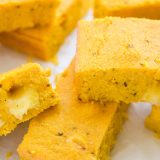On the hunt for a cornbread with robust corn flavor, gentle sweetness and a moist crumb, we found inspiration in Bolivia, where vendors hawk humintas—snack-size corn cakes laced with spices and sealed in husks—from street stalls.
Make no mistake, humintas are not cornbread as we know it. The savory, slightly sweet cakes often contain no cornflour or cornmeal, the main ingredients of American cornbread. Instead, they rely on ground fresh corn kernels. The result is a cake with clean, fresh corn flavor.
At their most basic, humintas are made by grating fresh corn and mixing it with eggs, sugar, lard and plenty of fresh, unaged cheese. Often, aniseed, with yellow ají chilies providing mild, fruity heat. The cheesy corn filling is traditionally wrapped in corn husks (similar to tamales, their cornmeal-based cousin) before being steamed or boiled.
At Milk Street, we borrowed inspiration from humintas’ robust flavor rather than its labor-intensive technique. Steaming or boiling—never mind wrapping anything in corn husks—was out. We wanted the fresh corn flavor, but we also wanted the ease and texture of a classic American cornbread. This meant sticking with baking.
It also meant keeping the cornmeal; using only grated fresh corn produced a batter with too much moisture for the bread to bake up with a light crumb. We struck a balance by using both fresh corn and cornmeal. The result was a sliceable yet moist cornbread with a subtle sweetness and plenty of corn flavor.
We liked the fruitiness of ají chilies, but they can be hard to find. So we pureed sweet orange bell pepper with fresh corn and milk. We also added aniseed, which worked well with the sweetness of the corn. A half-teaspoon of cayenne mimicked the gentle kick of the ajís.
For extra flavor, we substituted pepper jack cheese for the more traditional—and neutral—queso fresco. And rather than mixing all of it into the batter, where it might lose its impact, we created a layer of cheese by pouring half the batter into the pan, topping it with chunks of the cheese, then spreading the rest of the batter over the cheese.
The result was a cornbread that had elements both familiar and foreign. The bread was deeply savory and tender-crumbed, but it had a distinctly pronounced corn flavor and a mildly spicy finish from the cayenne and cheese. The pepper jack also enhanced the bread’s richness, while the aniseed heightened—rather than distracted from—the sweetness of the fresh corn.




